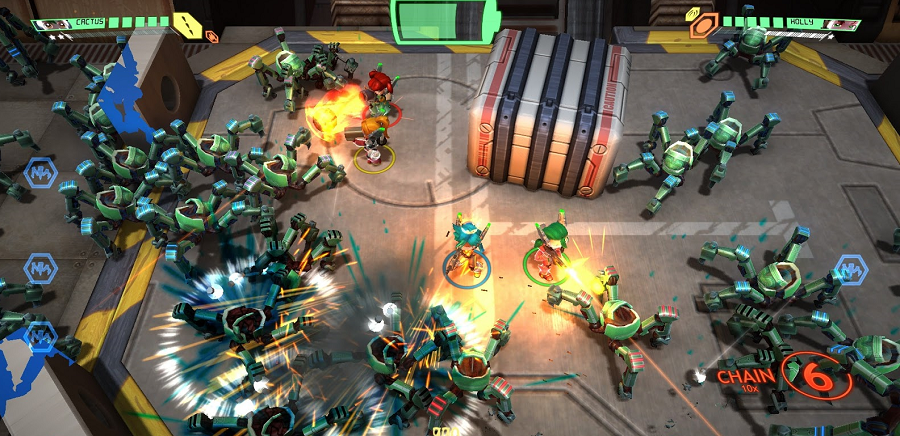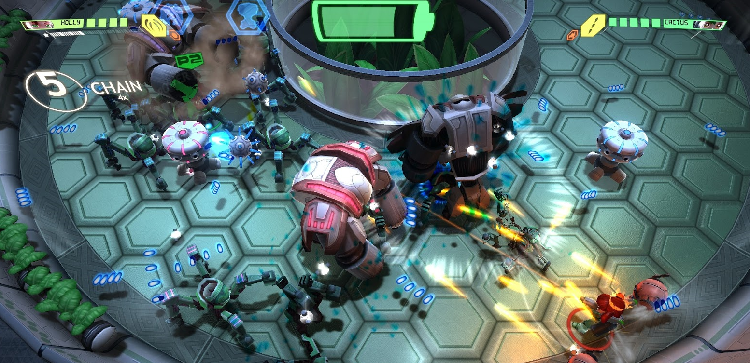Interview – Sanatana Mishra about Assault Android Cactus
 If you like your PC games fast, energetic, challenging and fun, Assault Android Cactus had better be on your watch list. The game is a twin stick shoot ’em up which features insane amounts of enemies on screen at any one time, and dazzles with eye-catching visuals. With support for up to 4 players at once, Assault Android Cactus is absolute bundles of fun and perfect for social gaming sessions. I recently caught up with Sanatana Mishra, the design guru from Witch Beam, the Brisbane based team responsible for Assault Android Cactus.
If you like your PC games fast, energetic, challenging and fun, Assault Android Cactus had better be on your watch list. The game is a twin stick shoot ’em up which features insane amounts of enemies on screen at any one time, and dazzles with eye-catching visuals. With support for up to 4 players at once, Assault Android Cactus is absolute bundles of fun and perfect for social gaming sessions. I recently caught up with Sanatana Mishra, the design guru from Witch Beam, the Brisbane based team responsible for Assault Android Cactus.
Save Game: Assault Android Cactus – tell us a little bit about it. For people who have never heard of it before, what would you want them to know?
Sanatana Mishra: Assault Android Cactus – it’s a bullet-hell twin stick shooter being made by a team called Witch Beam from Brisbane. There’s three of us: myself, Tim Dawson and Jeff Van Dyke. We’re all ex-industry folks coming from big studios like Creative Assembly, Sega and EA, and now we’re working on our own game, an indie game, and it’s smaller and more focused.
You came from a multitude of different studios, each doing their own thing. Why did you decide to break away from that and try your own thing?
SM: Part of it is, when you’re working in a big studio, the amount of resources that are going into the games, and the people who are putting those resources into the games, the people at the top who are making all the decisions, it ends up being that you can’t make games that are risky. You have to make games that are considered safe. But ultimately I don’t actually think that those games are safe, as you can see by the fact that every major studio in Brisbane has closed down. So I don’t know how safe it is to spend 20 million dollars on a game that’s all about sexualising everything and doing exactly what every other game has done for the last twenty years. With that being said, we are making a retro-style game but it is a modern take on a retro-style.
Do you find it difficult being based in Brisbane?
SM: It’s a bit of a tough one because at the moment we’re having a lull in Brisbane development – Melbourne is really going off and everyone in Melbourne is doing great and there’s so much support down here, whereas all the major studios in Brisbane are closed and a lot of people choose to leave rather than start up new indie studios. So it can be difficult. But for us, we’re just working all day every day on the game, so it’s not really too much about the community. We have some great events being run by the guys from right pedal studios – unity developer meetups and things like that so big props to them, and the Mana Bar hosting the big dev events. But it can be tough because it’s not the largest community.
Tell us more about Assault Android Cactus
SM: What we did was we took inspiration from our favourite games in the past which are all…for a lot of us traditionally being sega games, like the arcade games of the late nineties and early Dreamcast era. When you had four controller ports on a console and it actually mattered because everyone had four controllers. So we made a game that is wonderful playing as co-op. We made it bright, made it colourful, we made it inviting. The barrier of entry is not really there for anyone – we’ve had six year olds coming and playing it and we’ve also had 30 year olds coming and S+ ranking the levels, so the skill ceiling is quite high.
I guess I should explain what type of game it is – it’s a twin stick shooter. You’re moving with the left stick, aiming with the right stick, using the trigger to shoot and using the other trigger to switch to a secondary weapon that has a limited charge and it will recharge after you shoot all of its ammunition away. We also took a lot of inspiration from typical twin-stick games like Geometry Wars and Super Stardust, the modern example. So it’s super smooth to play – we didn’t want to have any lag in the controls, or moving slower when you’re moving backwards. We tried to move away from that. It’s smooth to move around, it’s smooth to shoot.
And for the gameplay, we’ve taken a lot more inspiration from the modern arcade games as well as the Saturn and Dreamcast classics like Radiant Silvergun and Ikaruga, so there’s a lot more bullet hell elements in the game. You have up to eight different characters, they all have unique weapons and we really wanted to push the idea that a character is a play style. You don’t grind and power up your character, you just pick the one that suits your playstyle and you push it through arcade style into the levels.
From my experience with Assault Android Cactus, it’s colourful, it’s bright, it’s nice and bold. You mentioned that it’s clean to play but it’s also streamlined in the way it looks. Is that something you were going for? It seems to be one of those games you can walk past and think ‘What’s someone playing there?!’ It looks inviting.
SM: We’ve had a couple of people come up and say ‘what’s this? I want to see it because it looks shiny.’
Shiny. Is that going to go on the back of the box when you’re selling it?
SM: I would love to have a box to put that on it. So we’ll have to see about that one. The response from people has been really great. Everyone who has played it has walked away with an incredibly positive impression. The hardest thing, even though it is attractive, is getting people to pick it up. I don’t think it is a typical twin-stick shooter. We’re trying to do something more. I hope that comes across in the gameplay.
In answer to your question, being shiny and being attractive is really important to us. The streamlining of the graphics is important because there’s so much going on. We use a lot of colour identities, where different colours represent a behaviour. Everything in blue will damage a player. Anything in yellow or orange will damage the enemies. Anything in red will damage both. So subliminally, a lot of the visual style and colourisation in the game is there to help you learn to play.
Awesome. Thank you very much!
I’ve had the chance to play Assault Android Cactus, and from my experience with it I found it to be lots of fun, and an absolute joy to play with friends. This is a game that’s great for people who enjoy gaming, and for people who don’t game much but enjoy being challenged. As Sanatana mentioned, it’s a fantastic game to introduce your non-gaming friends to the wonderful world of co-op gaming, and seeing the frantic, hectic action unfolding on screen is truly breathtaking. If you’ve yet to try this game out, I recommend you give it a go – it’s a fantastically addictive, challenging game that harkens back to what games should be – a damn lot of high quality fun.
For more information on Assault Android Cactus, check out its steam page or take a look at its official website. The team at Witch Beam are hoping to release Assault Android Cactus in Q1 2014, on Windows, OS X and Linux with digital releases planned for Playstation 4, Playstation Vita and WiiU.
A big thankyou to Sanatana Mishra for taking the time to chat with us, and for showing us the fantastic, enjoyable, beautiful Assault Android Cactus.




